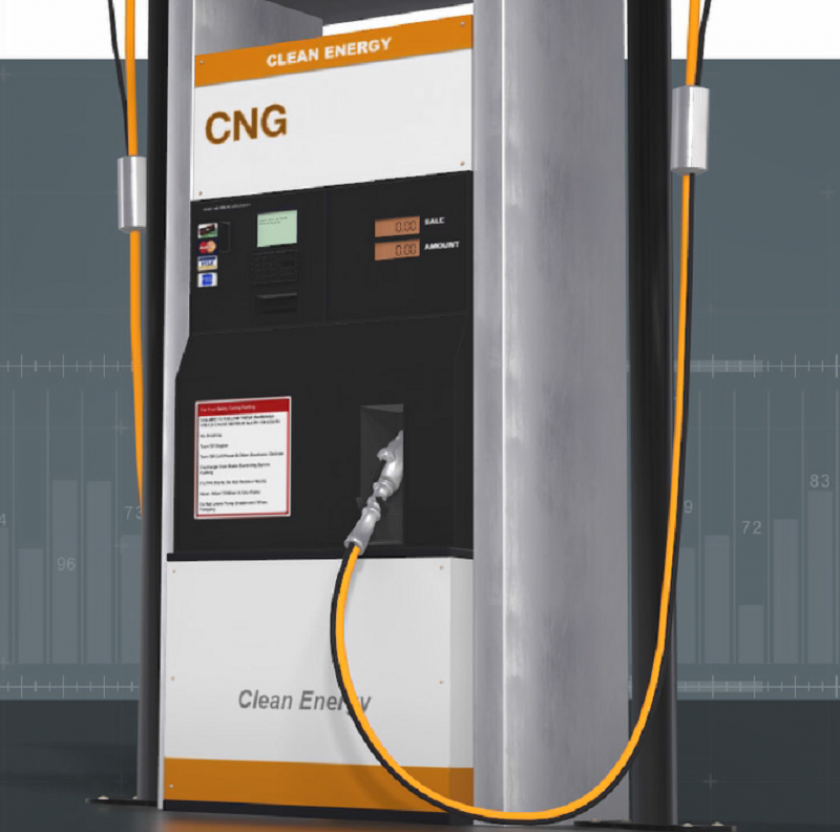Natural gas fuel cells
 Fot.
Fot.
Inside a fuel cell, the fuel (hydrogen gas) is delivered to the anode. There is also an oxidiser (oxygen or air) delivered to the cathode. In contact with the anode, the hydrogen gas releases electrons and becomes electrochemically oxidised to water. The water is removed from the fuel cell. The electrons released from the hydrogen atoms form an electron flux (which is electrical current at a low voltage, less than 1 volt per single fuel cell). The electron flux follows a circuit external to the fuel cell and reaches the cathode. If a sufficient number of fuel cells are connected in a stack, it can provide enough power for electrical loads. The oxygen in contact with the cathode becomes negatively charged ions. Within the electrolyte, the ions flow to the fuel cell’s anode, which makes the electrical circuit.
The electrolyte should have a high permeability to ions and zero permeability to electrons; otherwise, the external flux of electrons is not possible. The operating principle of a fuel cell is the reverse of electrolysis, by which water is reduced to hydrogen and oxygen by application of electrical current.
An advantage of electrical power generation with fuel cells is negligible emission levels (because it involves an electrochemical reaction instead of combustion in typical power generators). Aside from the manufacturability problems and service life, the greatest challenge to the development and general application of fuel cells is cost efficiency. For high-power fuel cell installations (and depending on the power generation technology), 1 kW requires an investment of USD 3,000 to USD 20,000.
An advantage of electrical power generation with fuel cells is negligible emission levels (because it involves an electrochemical reaction instead of combustion in typical power generators). Aside from the manufacturability problems and service life, the greatest challenge to the development and general application of fuel cells is cost efficiency. For high-power fuel cell installations (and depending on the power generation technology), 1 kW requires an investment of USD 3,000 to USD 20,000.
![Fuel cell principle [1]](/media/news_block/ogniwa1_image.png)
Fuel cell principle [1]
Different designs of fuel cells are in use. The primary difference between them is the electrolyte used:
- PEMFC (Polymer Electrolyte Membrane Fuel Cell/Proton Exchange Membrane Fuel Cell), where the electrolyte is a polymer membrane;
- AFC (Alkaline Fuel Cell), where the electrolyte is an alkaline chemical;
- PAFC (Phosphoric Acid Fuel Cell), where the electrolyte is phosphoric acid;
- MCFC (Molten Carbonate Fuel Cell), high-temperature power generating cells with molten carbonates as the electrolyte;
- SOFC (Solid Oxide Fuel Cell), where the electrolyte is a ceramic solid (and the fuel cells are high-temperature power generators).
- PEMFC (Polymer Electrolyte Membrane Fuel Cell/Proton Exchange Membrane Fuel Cell), where the electrolyte is a polymer membrane;
- AFC (Alkaline Fuel Cell), where the electrolyte is an alkaline chemical;
- PAFC (Phosphoric Acid Fuel Cell), where the electrolyte is phosphoric acid;
- MCFC (Molten Carbonate Fuel Cell), high-temperature power generating cells with molten carbonates as the electrolyte;
- SOFC (Solid Oxide Fuel Cell), where the electrolyte is a ceramic solid (and the fuel cells are high-temperature power generators).
Natural gas (abbreviated to NG) can be used as stock for the production of hydrogen supplying fuel cells by an external process (which is steam reforming of NG) to power PEMFCs and PAFCs; hydrogen is also a viable fuel for the high-temperature MCFCs and SOFCs. NG can be steam-reformed inside a fuel cell (by application of heat and steam, a product of fuel cell operation).
NG requires thorough desulphurisation to become a viable stock for fuel cells; sulphur is detrimental to anodic catalysts. Sulphur occurs naturally in mined NG; tetrahydrothiophene (THT), a compound of sulphur, is added to odourise NG for safety. The sulphurisation of natural gas is a common problem.
NG requires thorough desulphurisation to become a viable stock for fuel cells; sulphur is detrimental to anodic catalysts. Sulphur occurs naturally in mined NG; tetrahydrothiophene (THT), a compound of sulphur, is added to odourise NG for safety. The sulphurisation of natural gas is a common problem.
Note that the sensitivity of a fuel cell to sulphur compounds is reduced as the temperature of the fuel cell rises. MCFCs are up to five times more sensitive to damage by sulphur compounds than SOFCs (since the latter fuel cell type works at a higher temperature). Another challenge is the sensitivity of fuel cells to carbon monoxide (CO), a gas generated by steam reforming of NG. Here, the CO tolerance limits in PEMFC are only several ppm of CO, while SOFC is the fuel cell type most resilient to damage from CO and its tolerance limit is several thousand ppm of carbon monoxide.
SOFC seem to be the most promising fuel cell fed directly with NG.
SOFC seem to be the most promising fuel cell fed directly with NG.
The electrolyte in SOFC is zirconium oxide (ZrO2) stabilised with yttrium oxide (Y2O3). The operating temperature range of SOFC is 650-1000°C.
The SOFC anode reaction is: H2 + O2- → H2O + 2e-
The SOFC cathode reaction is: O2 + 2e- → 2O2-
SOFCs provide a high efficiency (45-60%) and a relatively long service life (up to 40,000 h). Unlike other fuel cell types, SOFCs are uncomplicated in design and inexpensive (the electrolyte is a solid body, and the fuel cells require no precious metals, like platinum). Another advantage of SOFCs is the freedom of form (SOFCs can be flat, monolithic or tubular).
The SOFC anode reaction is: H2 + O2- → H2O + 2e-
The SOFC cathode reaction is: O2 + 2e- → 2O2-
SOFCs provide a high efficiency (45-60%) and a relatively long service life (up to 40,000 h). Unlike other fuel cell types, SOFCs are uncomplicated in design and inexpensive (the electrolyte is a solid body, and the fuel cells require no precious metals, like platinum). Another advantage of SOFCs is the freedom of form (SOFCs can be flat, monolithic or tubular).
Tubular SOFCs seem to be of particular interest: the inner surface (or layer) is the anode (in contact with the fuel), and the outer surface (layer) is the cathode (in contact with oxygen or air). The intermediate layer between the two is the electrolyte. A single SOFC is 22 mm in diameter, 1.5 m long, and has the following thickness of each layer: the anode of 100 µm, the electrolyte of 40 µm, and the cathode of 2 mm. The SOFCs are connected into stacks with dedicated nickel bridges.
The high operating temperature of SOFCs is a source of waste heat which can drive power generators; SOFCs can be used in power engineering applications (for example, by combination with a gas turbine). These co-generation systems can be configured with an output in the megawatt range and very high efficiency – of up to 80%.
The high operating temperature of SOFCs is a source of waste heat which can drive power generators; SOFCs can be used in power engineering applications (for example, by combination with a gas turbine). These co-generation systems can be configured with an output in the megawatt range and very high efficiency – of up to 80%.
![Westinghouse-Siemens SOFC [3]](/media/news_block/ogniwa4-2_image.png)
Westinghouse-Siemens SOFC [3]
The disadvantages of SOFCs include: problematic open porosity of the electrolyte material, difficulties in sealing of SOFC stacks, a high operating temperature which requires superior performance of materials and joint operation with auxiliary systems (for preheating, performance stability, cooling, etc.), and a complex startup procedure.
In recent years, many fuel cell manufacturers began researching the commercialisation of NG fuel cells both in low-power versions (of several kilowatts) and in the form of large-scale power generating installations rated at several hundred kilowatts or more.
In recent years, many fuel cell manufacturers began researching the commercialisation of NG fuel cells both in low-power versions (of several kilowatts) and in the form of large-scale power generating installations rated at several hundred kilowatts or more.
In the low-power range, the research featured test applications of PEMFCs with NG cleaning and reforming (this fuel cell type was used in approximately 85% of fuel cell systems) and SOFCs. In the high-power range, installations based on PAFCs, MCFCs and SOFCs were tested.
Today, the only commercially available NG fuel cells are the PureCell 200 and PureCell 400 units manufactured in Japan. Depending on the model, a PureCell unit can co-generate 200 kW or 440 kW of electricity and 250 kW or 290 kW of heat, respectively. The PureCell units are based on PAFC, an older fuel cell technology. Approximately 300 units have been sold worldwide. The PureCell system features an external hydrogen generation system (working by NG reforming) to power the fuel cells.
Today, the only commercially available NG fuel cells are the PureCell 200 and PureCell 400 units manufactured in Japan. Depending on the model, a PureCell unit can co-generate 200 kW or 440 kW of electricity and 250 kW or 290 kW of heat, respectively. The PureCell units are based on PAFC, an older fuel cell technology. Approximately 300 units have been sold worldwide. The PureCell system features an external hydrogen generation system (working by NG reforming) to power the fuel cells.
In 2018, the Georgia Institute of Technology developed a SOFC-based technology operating at much lower temperatures (approximately 500°C, which is below the operating temperature limits of internal combustion engines). The operating temperatures make widely available and less expensive materials viable for the technology. It could be a major step towards the commercialisation of direct NG fuel cells.
The cost of a fuel cell installation must be reduced to USD 1000 per 1 kW; it is key to prompt a serious interest of the market in fuel cells, facilitate large-scale commercialisation and increase the share of fuel cells in the green energy mix.
The cost of a fuel cell installation must be reduced to USD 1000 per 1 kW; it is key to prompt a serious interest of the market in fuel cells, facilitate large-scale commercialisation and increase the share of fuel cells in the green energy mix.
Sources:
[1] http://www.ogniwa-paliwowe.info/sofc.php
[2] Energia XXII – Ciepło, Elektroenergetyka, Gaz Dodatek reklamowy do RZECZPOSPOLITEJ. nr 86 (5556) 11 kwietnia 2000 r. Nowoczesne technologie użytkowania gazu Siła napędowa rynku gazowego w Polsce
http://geoland.pl/dodatek/energia-xxii/nowoczesne-technologie-uzytkowania-gazu
[3] Stacjonarne ogniwa paliwowe, M. Chaczykowski, Nowoczesne Gazownictwo 1 (XI) 2006 https://fluidsystems.pl/pl/d/7e6bcb54fcd989007f1ac11b5f28615c
[4] PureCell Heat and Power Solutiuon, folder UTC Power, http://www.iatroma.com/cataloghi/PureCell.pdf
[5] Doosan PureCell Model 400 datasheet http://www.doosanfuelcellamerica.com/download/pdf/catalog/pafc-400kw_us_en.pdf
[1] http://www.ogniwa-paliwowe.info/sofc.php
[2] Energia XXII – Ciepło, Elektroenergetyka, Gaz Dodatek reklamowy do RZECZPOSPOLITEJ. nr 86 (5556) 11 kwietnia 2000 r. Nowoczesne technologie użytkowania gazu Siła napędowa rynku gazowego w Polsce
http://geoland.pl/dodatek/energia-xxii/nowoczesne-technologie-uzytkowania-gazu
[3] Stacjonarne ogniwa paliwowe, M. Chaczykowski, Nowoczesne Gazownictwo 1 (XI) 2006 https://fluidsystems.pl/pl/d/7e6bcb54fcd989007f1ac11b5f28615c
[4] PureCell Heat and Power Solutiuon, folder UTC Power, http://www.iatroma.com/cataloghi/PureCell.pdf
[5] Doosan PureCell Model 400 datasheet http://www.doosanfuelcellamerica.com/download/pdf/catalog/pafc-400kw_us_en.pdf



